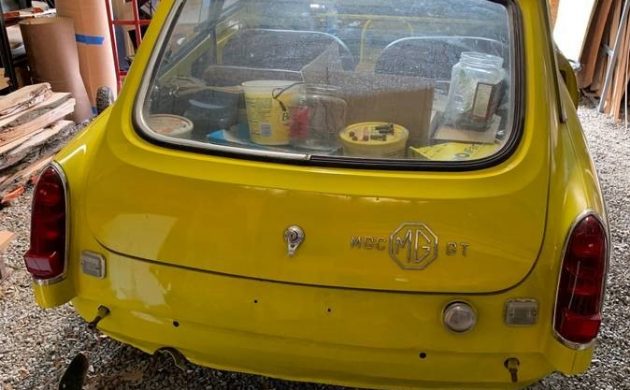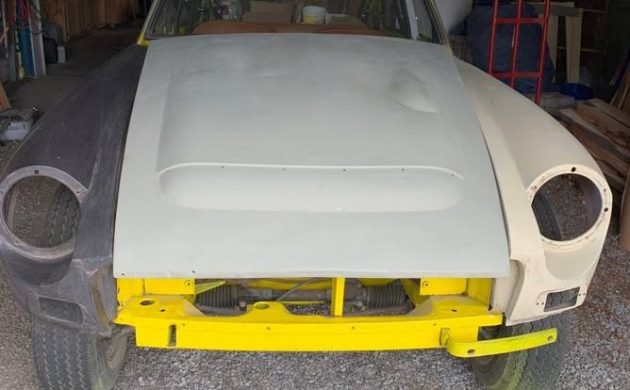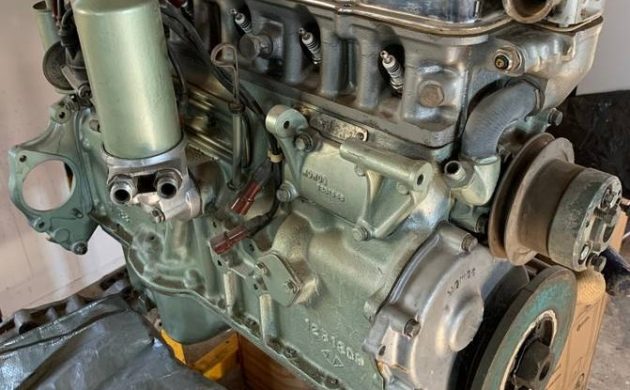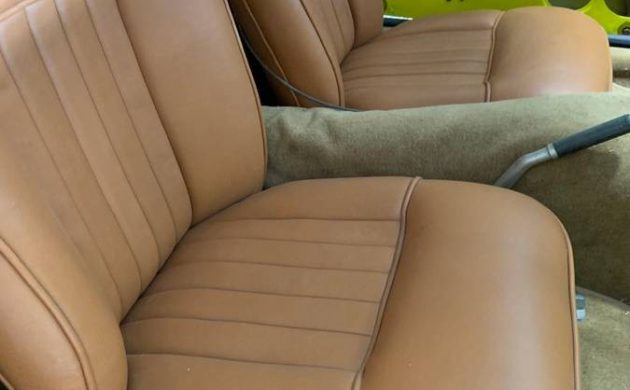The MGC was an extension of the British-built MGB and its claim to fame was that it used a six-cylinder engine instead of four to propel the sports car. Thus, the MGC was more powerful and could reportedly go 20 mph faster than the machine it was based upon. This ’69 is the GT edition, meaning that it’s an enclosed coupe rather than a roadster. Located in Spokane Valley, Washington, this project was started but will need additional work and reassembly. Available here on craigslist, the seller will let it go to the first party who shows up with $5,000 cash money. Thanks for the head-up here, Matt H.!
Craftsmen at British Motor Corp. created the MGC out of the MG. Considerable revisions were required around the engine bay and the floor plan to accommodate a 2,912 cc straight-six engine. The new car was certainly faster than its corporate cousin but the additional weight up front changed its handling characteristics which were not necessarily for the good. It was less nimble in the corners than the MGB but could flat outrun the other in the straightaways. Reports are that about 4,500 of the MGCs were built in total, and the seller estimates that about 2,000 of the GT coupe versions made it to the U.S. between 1967-69. Production stopped after that.
From the seller’s details, we assume this is a project he’s been working on for some time. Unfortunately, age has gotten in the way, and this is no longer something he can complete. It looks to be in a garage/barn and is in various stages of assembly or disassembly, depending on how you look at it. We’re told the body has been sanded and rusted parts removed and painted. The car’s fenders, hood, and front bottom plate will need to be lightly sanded and painted. Should you like the yellow color the seller is working with, he has some extra paint for you, but more will likely be needed.
The motor selected for this project came from an Austin Healey 3000 and looks to have been rebuilt and ready to go into the car. A bit more work is needed, such as the distributor being updated with the ignition and the alternator requires a rebuild. The available transmission is a 4-speed with a 5th electric overdrive and it will need fluid before being installed. The clutch is new, the radiator has been re-cored, and some brake work has been done, though not all of it. The wiring hasn’t been touched and may need replacing or at least a check for repairs.
A complete interior kit is part of the transaction, though new real leather seats are already bolted in, and the carpeting looks to have been put in. The steering wheel and instrument panel will require installation. Since we’re told the car is complete, what’s not on the car presently must be in the boxes shown in the seller’s garage. This should be a great and rare car when completed, but finishing projects started by others should always require a thorough assessment on the part of the buyer.






At that price this car is not going to be for sale very long. Nice project.
Amen to that, Bob! I sure wouldn’t let mine go for that price. The AH engine is interesting: four main bearings instead of seven. Probably lighter with quicker throttle response, but as durable?
Love the boot floor with the MG logo and finished hardwood.
So I guess the passenger door doesn’t close fully?
The motor used in the MGC did not come from the Austin Healey. it is a BMC “C” series engine but it was a redesign common to the Austin 3-litre sedan, and this 5-main-bearing version was never used in the Austin-Healey cars. This was part of the problem of why the MGC never caught on, the redesigned “C” series engine was flawed in several ways and not as good as the original version used in the Healeys.
The Laycock over-drive is not “electric”…it’s hydraulically operated. the only electric part is the switching system to operate the solenoid that contolrs the oil pressure.
I’d agree – that this is a decent project. if the body is straight and pretty much rust free and all the original parts are present. Ironically, these 6-cylider cars are worth a good bit more than their 4-cylinder MGB cousins.. they were not successful when new so are relatively rare and collectible now.
From what I’ve read in the past, the “issues” with this version of the “C” series motor can be remedied with a few well documented upgrades and modifications. They can be made into really competent, fast, grand tourers, even if they will never be as well balanced and nimble as a good “B”…
I also recall the story that the original press cars for the launch were supplied with under inflated front tire pressures (I believe that is true, not some urban legend). Low tire pressures combined with the extra weight up front made them understeer badly and that is something the press road testers wrote up… giving these cars a bad rep from the start >?
sorry..in my original post I said “5 main bearing” …I meant to say “7 main bearing”
I was home on leave in 1969.I dropped in at the body shop where I used to work, and got to deliver a MGC roadster to its owner. I had driven many MGB’s and big Healey’s.
In a straight line it was great. I didn’t hoon it, as it wasn’t mine. But even in normal cornering, you could tell there was something heavy in the nose. I would take one over an MGB.
Back when my brother and I were into British cars, we had a few MG-B’s, and he had an Austin Healey BJ8. Were rebuilt the engines on many of our cars. Considering the ridiculous weight of the Healey engine, I can’t imagine how negatively that would impact the well balanced little B chassis. I think there was a good reason why they stopped production.
They lowered (raised?) the steering ratio on the Cs. Whereas the Bs were 2.9 turns, lock-to-lock, the Cs were 3.5. Result was very pleasant, light steering – a big surprise given the engine weight. Toward the end of production, they went to 3.5 on the Bs too.
ClassicCarFan is right about the engine but I wouldn’t call it “flawed”. In fact, it’s practically indestructible! ‘ Think it was designed as a Holden truck engine. Adding the number of main bearings distributes the wear further and increases the crankshaft support significantly, but in so doing, it increases the amount of bearing friction, making the engine less responsive, less willing to rev freely. Not a flaw, just a design choice. In this case, it was perhaps a less attractive choice for a sports car engine. Exactly the same issue comes to bear on 3-main vs 5-main MGB engines. The three-main versions have been noted to rev more quickly and responsively, but nobody would describe the five-main engines as “flawed”. And yes, in both cases, there are some aftermarket tweaks that more-than make up for the losses in power that come with more main bearings.
I too have heard about the role tire inflation guidelines of the late sixties played in the evaluation of the MGC. I don’t know if this story is true or not, but it is certainly plausible, and likely.
‘ Bought my own C/GT as a grand tourer anyway. Mine is a four-speed with overdrive, and now, a 3.07 CW&P. At 2,000 rpm, I’m doing 60 mph. Ain’t that “Grand”?! I don’t throw my cars around much – for one thing, here in SE Michigan, there are few places around which to throw them. Occasionally, a low-traffic roundabout is the best I can do.
I always presumed the reason for the demise of the Big Healey was the onslaught of American emissions regulations slated for 1968. That would partially account for performance distinctions between the Big H and the MGC. No?
Writer refers to “craftsmen at “BMC.” If they really were craftsmen, perhaps quality wouldn’t have floundered so and there would still be a BMC.
The tire story came along many years after the fact. I don’t believe it, and even if true, what does that say about the management.
I do remember a friend swapping an unreliable S2 Elan for a 6 month old MGC. It was quite fast on fast roads but clumsey in nearly everything else. Now relative rarity means the MGC is valued higher, but not sure why you’d want one.
The best MGB was the MGB GTV8. Only 2500 built, all RHD, it used a detuned 140 bhp Rover/Buick V8. All alloy, actually lighter than the regular B series engine, so car is rare, quick and handles well.
Unlike the MGC….
ChingaTrailer – substitute the word “managers” for the word “craftsmen” and substitute the letters “BL” for the letters “BMC” and I think you have it.
I think we’re both right but one must admit that BMC quality wasn’t all that great before it devolved into British Leyland.
Bob, You’re right about protecting the market for the “shape of things to come” – aka “the wesdge”, aka the TR7. That’s why the B/GT was removed from the North American market after 1974. But that chronology does not work with the Healey’s exit in 1968. Sheer speculation here but could it be that modifications to suit the new American emissions restrictions did not sit well with Donald Healey so he revoked the license? I do recall reading somewhere that Healey refused to endorse the MGC.
I don’t know how much of a bargain this car is. The replacement front sheet metal suggests this car initiated a rear-end collision. The hood is just laying in place. The reason the doors won’t close likely due to interference from the fenders. A peek at the engine compartment might show additional damage.
I can’t speak of rewiring a C but I’ve done it on a couple of Bs. It’s not that difficult if a proper replacement loom is on hand. The real bear is re-installing the dash. There are six studs under the dash which go in the holes below the windshield. Putting the nuts on those studs is not an easy task. Once the dash is in place and centered it’s time to tighten those nuts. Even with the seats removed it helps to be a contortionist used to working by feel.
Someone got over their head with this project. There’s much work to be done.
That’s an interesting tale about a Holden truck engine in the origins of C-series engine, but one I’ve never seen in any written source before. Do have a link to any reliable source of information for that? The engine was designed in-house Morris Engines drawing office in Coventry and was in essence an enlarged overhead valve development of the earlier 2.2 L Straight-6 overhead camshaft engine used in the post-war Morris Six MS and Wolseley 6/80 from 1948 until 1954.
There’s an extensive write-up of the development history of the C-series engine on the UK site AROnline, no mention anywhere in there of Holden in the origins. https://www.aronline.co.uk/engines/c-series/
Describing something as flawed is always a subjective measure. The redesigned version of the C-series engine ended up being less powerful, and less fuel efficient than the earlier C-series engine it was supposed to improve on. Many sources have confirmed that the MGCs as factory standard were well short of the ‘claimed’ 145 bhp. The two cars that engine powered were dismal sales failures. The MGC was unceremoniously dropped after just two years in production. So, yes, I’d call it a flawed effort.
Note: the Healeys went away when the conglomerate which absorbed every brand of small sports cars wanted no competition for the new TR7. The weakness in the the Cs was weak front springs, too small a roll bar and shocks that pretty much did nothing for a living on the cars. Upgrading the suspension on both ends does wonders for the handling.
Bob, You’re right about protecting the market for the “shape of things to come” – aka “the wesdge”, aka the TR7. That’s why the B/GT was removed from the North American market after 1974. But that chronology does not work with the Healey’s exit in 1968. Sheer speculation here but could it be that modifications to suit the new American emissions restrictions did not sit well with Donald Healey so he revoked the license? I do recall reading somewhere that Healey refused to endorse the MGC.